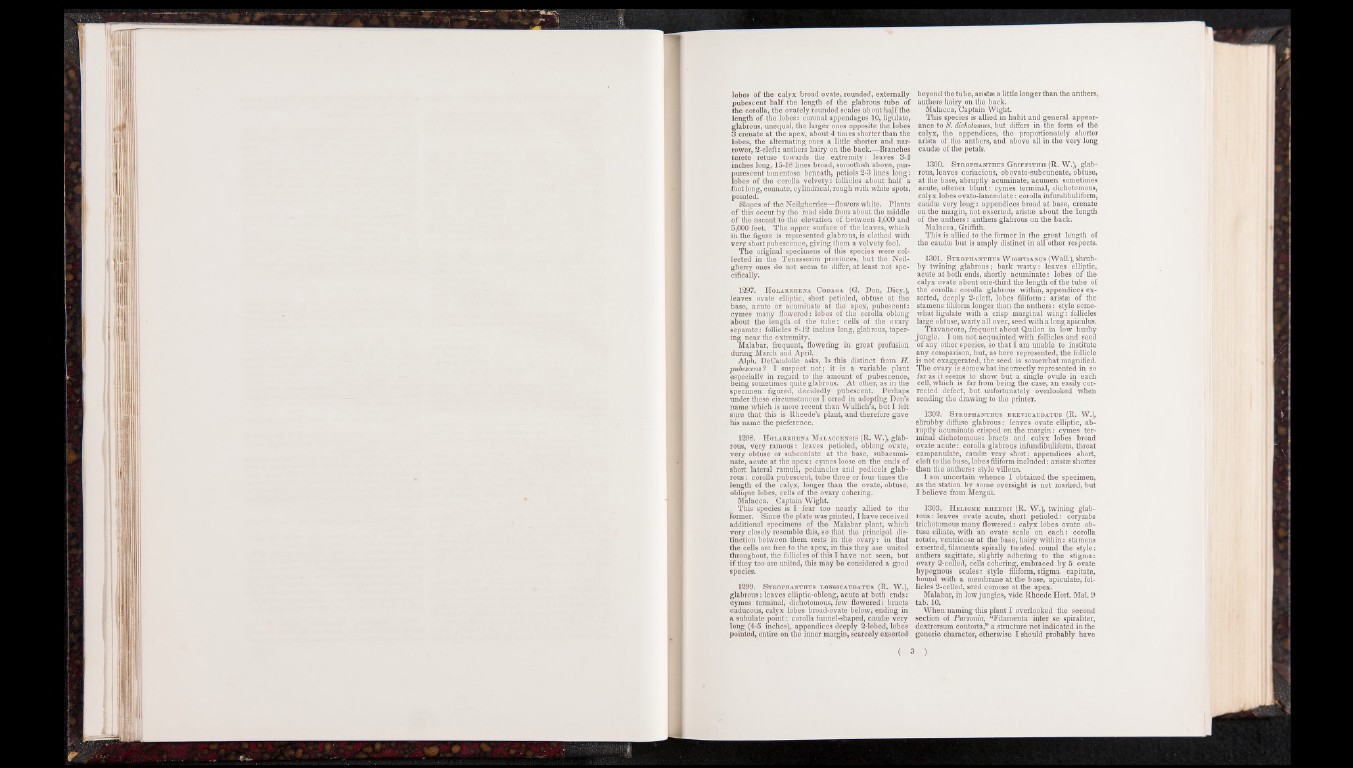
lobes of the calyx broad ovate, rounded, externally
pubescent half the length of the glabrous tube of
the corolla, the ovately rounded scales about half the
length of the lobes: coronal appendages 10, ligulate,
flabrous, unequal, the larger ones opposite the lobes
crenate at the apex, about 4 times shorter than the
lobes, the alternating ones a little shorter and narrower,
2-cleft: anthers hairy on the back.—Branches
terete retuse towards the extremity: leaves 3-4
inches long, 15-18 lines broad, smoothish above, pur-
purescent tomentose beneath, petiols 2-3 lines long':
lobes of the corolla velvety: follicles-about half a
foot long, connate, cylindrical, rough with white spots,
pointed.
Slopes of the Neilgherries—flowers white. Plants
of this occur by the road side from about the middle
of the ascent to the elevation of between 4,000 and
5,000 feet. The upper surface of the leaves, which
in the figure is represented glabrous, is clothed with
very short pubescence, giving them a velvety feel.
The original specimens of this species were collected
in the Tenasserim provinces, but the Neil-
gherry ones do not seem to differ, at least not specifically.
1297. Holarrhena C odaga (G. Don, Dicy.),
leaves ovate elliptic, short petioled, obtuse at the
base, acute or acuminate at the apex, pubescent:
cymes many flowered: lobes of the corolla oblong
about the length of the tube: cells of the ovary
separate: follicles 8-12 inches long, glabrous, tapering
near the extremity.
Malabar, frequent, flowering in great profusion
during March and April. /
Alph. DeCandolle asks, Is this distinct from H.
pubescens? I suspect not; it is a variable plant
especially in regard to the amount of pubescence,
being sometimes quite glabrous. At other, as in the
specimen figured, decidedly pubescent. Perhaps
under these circumstances I erred in adopting Don’s
name which is more recent than Wallich’s, but I felt
sure that this is Rheede’s plant, and therefore gave
his name the preference.
1298. Holarrhena Malaccensis (R. W.), glabrous,
very ramous: leaves petioled, oblong ovate,
very obtuse or sub cordate at the base, subacuminate,
acute at the apex: cymes loose on the ends of
short lateral ramuli, peduncles and pedicels glabrous
: corolla pubescent, tube three or four times the
length of the calyx, longer than the ovate, obtuse,
oblique lobes, cells of the ovary cohering.
Malacca. Captain Wight
t This species is I fear too nearly allied to the
former. ‘ Since the plate was printed, I have received
additional specimens of the Malabar plant, which
very closely resemble this, so that the principal distinction
between them rests in the ovary: in that
the cells are free to the apex, in this they are united
throughout, the follicles of this I have not seen, but
if they too are united, this may be considered a good
species.
1299. Strophanthus longicaudattjs (R. W.),
glabrous: leaves elliptic-oblong, acute at both ends:
cymes terminal, dichotomous, few flowered: bracts
caducous, calyx lobes broad-ovate below, ending in
a subulate point: corolla funnel-shaped, caud* very
long (4-5 inches), appendices deeply 2-lobed, lobes
pointed, entire on the inner margin, scarcely exserted
beyond the tube, aristas a little longer than the anthers,
anthers hairy on the back.
Malacca, Captain Wight.
This species is allied in habit and general appearance
to S. dichotomies, but differs in the form of the
calyx, the appendices, the proportionately shorter
arista of the anthers, and above all in the very long
caudse of the petals.
1300. Strophanthus Griffithii (R. W.), glabrous,
leaves coriacious, obovato-subcuneate, obtuse,
at the base, abruptly acuminate, acumen sometimes
' acute, oftener blunt: cymes terminal, dichotomous,
calyx lobes ovato-lanceolate: corolla infundibuliform,
caudas very lon g: appendices broad at base, crenate
on the margin, not exserted, arista; about the length
of the anthers: anthers glabrous on the back.
Malacca, Griffith.
This is allied to the former in the great length of
the caudas but is amply distinct in all other respects.
1301. Strophanthus W ightianus (Wall.), shrubby
twining glabrous; bark warty: leaves elliptic,
acute at both ends, shortly acuminate: lobes of the
calyx ovate about one-third the length of the tube of
the corolla: corolla glabrous within, appendices exserted,
deeply 2-cleft, lobes filiform: arista; of the
stamens filiform longer than the anthers: style somewhat
ligulate with a crisp marginal w in g : follicles
large obtuse, warty all over, seed with a long apiculus.
Travancore, frequent about Quilon in low bushy
jungle. I am not acquainted with follicles and seed
of any other species, so that I am unable to institute
any comparison, but, as here represented, the follicle
is not exaggerated, the seed is somewhat magnified.
The ovary is somewhat incorrectly represented in so
far as it seems to show but a single ovule in each
cell, which is far from being the case, an easily corrected
defect, but unfortunately overlooked when
sending the drawing to the printer.
1302. Strophanthus brevicaudatus (R. W.),
shrubby diffuse glabrous: leaves ovate elliptic, abruptly
acuminate crisped on the margin: cymes terminal
dichotomous: bracts and calyx lobes broad
ovate acute: corolla glabrous infundibuliform, throat
campanulate, caudee very short: appendices short,
cleft to the base, lobes filiform included: aristae shorter
than the anthers: style villous.
I am uncertain whence I obtained the specimen,
as the station by some oversight is not marked, but
I believe from Mergui.
1303. Heligme rheedii (R. W.), twining glabrous:
leaves ovate acute, short petioled: corymbs
trichotomous many flowered: calyx lobes ovate obtuse
ciliate, with an ovate scale on each: corolla
rotate, ventricose at the base, hairy within: stamens
exserted, filaments spirally twisted round the style:
anthers sagittate, slightly adhering to the stigma:
ovary 2-celled, cells cohering, embraced by 5 ovate
hypognous scales: style filiform, stigma capitate,
bound with a membrane at the base, apiculate, follicles
2-celled, seed comose at the apex.
Malabar, in low jungles, vide RheedeHort. Mai. 9
tab. 10.
When naming this plant I overlooked the second
section of Parsonia, “Filamenta inter se spiraliter,
dextrorsum contorta,” a structure not indicated in the
generic character, otherwise I should probably have